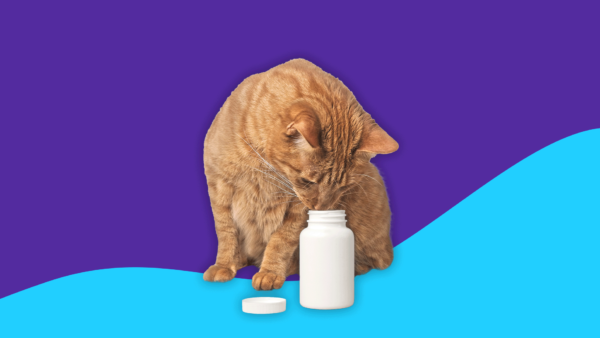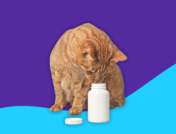Key takeaways
Azithromycin is used to treat bacterial infections in cats.
The standard azithromycin dosage for cats is 5–10 milligrams (mg) per kilogram (kg) of body weight given every 24 hours.
The most common side effects of azithromycin in cats are nausea, vomiting, diarrhea, and abdominal discomfort.
Do not give azithromycin to cats if the cat is allergic to azithromycin or similar drugs (macrolide antibiotics).
Azithromycin (brand name Zithromax) is a commonly used antibiotic that treats a broad spectrum of bacterial infections in cats, including skin infections, upper respiratory tract infections, pneumonia, bronchitis, and blood infections. Its use in cats is “off-label,” meaning that the U.S. Food and Drug Administration (FDA) has not approved the drug for use in companion animals. Treatment lasts only a few days, with relatively minimal potential side effects. When cats have problems, they usually involve gastrointestinal issues like nausea or diarrhea.
RELATED: Save up to 80% on azithromycin
What is azithromycin used for in cats?
Azithromycin is used to treat a wide range of bacterial infections in cats. It’s not always the first antibiotic a veterinarian would choose, but veterinarians commonly use it.
Bacterial infection
In cats, azithromycin is used against any infection caused by bacteria that can be affected by drugs like azithromycin. These include Staphylococcus (“staph” infections) and Streptococcus (“strep” infections), as well as other common bacteria well-known to veterinary professionals. These types of bacterial infections can affect the upper respiratory tract, the skin, the lungs (bronchitis or pneumonia), the blood, the abdomen, and the urinary and genital tracts. Veterinarians also use it for chronic upper respiratory tract infections when other antibiotics have failed.
Some infections in humans or dogs are commonly treated with azithromycin. These include Bordetella, chlamydia, and mycoplasma (pneumonia). However, azithromycin isn’t effective against these infections in cats, so other antibiotics are used.
Azithromycin belongs to a family of drugs called macrolides. Easily recognizable by the “-mycin” at the end of their names, macrolide antibiotics stop bacteria from growing. They do this by preventing the bacteria from making needed proteins. Veterinary professionals call this type of antibiotic “bacteriostatic. These drugs don’t kill the bacteria—those drugs are called bactericidal—but simply stop the bacteria from dividing. Over a short time, the immune system ends the infection by killing off the remaining bacteria.
As in humans, azithromycin lasts long in a cat’s body, so only one dose per day is required. Some dosage guidelines advise that doses be given every two to three days. Another advantage of azithromycin is that it concentrates in white blood cells, the immune system’s front line for fighting infections. In this way, the body’s immune system functions like a drug delivery system since the white blood cells naturally travel to the infection.
RELATED: When does your pet need antibiotics?
Is azithromycin safe for cats?
Veterinarians consider azithromycin safe for cats. It is a common choice in veterinary medicine for clearing up bacterial infections.
Azithromycin is never given to cats with hypersensitivity to azithromycin or any other macrolide antibiotic.
Veterinarians use azithromycin with caution in cats with liver disease. Cats with impaired liver function will not efficiently break down the drug, increasing the risk of potential side effects.
Side effects of azithromycin in cats
The most common side effects of azithromycin in companion animals are digestive system problems such as:
- Reduced appetite
- Diarrhea
- Vomiting
In animals, the most serious side effects include:
- Liver dysfunction
- Allergic reactions (angioedema)
- Heartbeat irregularities
Call a veterinarian if you notice signs of a potentially serious side effect of azithromycin, such as:
- Yellowing of the cat’s eyes, gums, or skin
- Swelling of the cat’s mouth or face, trouble breathing, or wheezing
Interactions of azithromycin with other pet meds
Azithromycin has many documented drug interactions, so tell the prescribing veterinarian about all the drugs, supplements, and herbal remedies you regularly give the cat. In particular, tell the veterinarian if the cat is being given:
- Other macrolide antibiotics
- Cisapride: In people, the heartburn medication cisapride is contraindicated for use with azithromycin
- Antacids: Oral antacids will reduce the absorption of azithromycin, reducing its effectiveness
- Cyclosporine: Azithromycin may increase the concentration and effects of the immune suppressant cyclosporine
- Blood thinners: In humans, azithromycin might increase the concentrations of some blood thinners, such as warfarin, increasing the risk of bleeding episodes
Azithromycin dosage for cats
According to Plumb’s Veterinary Drug Manual, recommended azithromycin doses are as follows:
- For infections due to susceptible bacteria: 5–10 mg/kg daily for 3–7 days. If a longer duration of treatment is needed, it may be continued at 5-10 mg/kg every 48-72 hours or at 10-15 mg/kg twice weekly
- For skin infections: 5-10 mg/kg once daily for 5–7 days
- For upper respiratory tract infections: 5–10 mg/kg daily for 5 days followed by 5–10 mg/kg every three days for 6–8 weeks
- For Bartonellosis (cat scratch disease): 10 mg/kg daily for 21 days
Since azithromycin is not FDA-approved for cats, cat parents will need to dose their cat with human formulations or those specially prepared at a compounding pharmacy.
Can cats overdose on azithromycin?
Veterinary science has not determined a maximum dosage of azithromycin in animals. As a best practice, do not give the cat bigger doses than those prescribed by the veterinarian.
If a cat has been given too much azithromycin, immediately contact your veterinarian or a veterinary hospital. In humans, the most common signs of an overdose are nausea, vomiting, and diarrhea.
Can I give my cat azithromycin every day?
To be effective, cat owners need to dose the cat once daily for two days to two months.
Long-term antibiotic use is not advised in humans or animals because of the risk of bacteria developing antibiotic resistance.
How to give your cat azithromycin
Azithromycin is only a short-term medication, so it should be easy to administer without missing doses. The one exception is chronic upper respiratory infections. In those cases, azithromycin may need to be given to a cat for two months, but doses are given every three days.
Here are a few tips:
- Follow all the veterinarian’s instructions.
- Do not change the dose or dosing schedule.
- Do not miss a dose.
- Administer doses for the full duration of treatment. Although the cat may behave normally after only one dose, the entire treatment is required to prevent the infection from coming back.
How to give a cat azithromycin tablets:
- Azithromycin tablets must be given with food.
- If you don’t know how to give tablets to a cat, ask a veterinary technician or other veterinary professional to demonstrate the proper technique. You can also get a pill plunger but have a veterinary professional show you the correct technique for using one.
- Store the tablets at room temperature.
How to give a cat azithromycin oral suspension:
- Azithromycin oral suspension should be given on an empty stomach.
- Shake the bottle before measuring each dose.
- Use a calibrated oral syringe to measure doses.
- Have a veterinary professional demonstrate the proper technique for giving the dose to the cat.
- Do not refrigerate the oral suspension. Store it at room temperature for up to 10 days. After 10 days, throw the medicine away.
If a dose is missed, give it when remembered. Administer the next dose as scheduled. Do not give a cat a double dose to make up for a missed dose.
Azithromycin alternatives for cats
Although azithromycin is a popular antibiotic in veterinary medicine, it is not always the first choice to treat infections in cats.
Home remedies are a possible alternative if the cat is not very sick or feverish. Talk to a veterinarian first, but a cat with mild symptoms like sneezing can be helped by:
- Maintaining an adequate diet
- Probiotics
- Antiseptics for skin infections
- Symptom relief remedies (ask a veterinarian first)
When antibiotics are needed, the alternatives will depend on the type of infection and the bacteria involved. If azithromycin can’t be used, one choice is to use another macrolide, such as erythromycin. Azithromycin is used for infections commonly treated by penicillins like amoxicillin-clavulanate, so these are possible alternatives. Other treatment options include tetracyclines or fluoroquinolones.
The American Association of Feline Practitioners (AAFP) and the American Animal Hospital Association (AAHA) consider prevention the best treatment for animal infections. Pet parents should take active measures to keep their pets free from bacterial infections through:
- Vaccinations
- Parasite control (for instance, by using monthly flea and tick topicals)
- Proper nutrition
- Safe, healthy, and stress-free home life
- Regular veterinary check-ups
- Proper dental care
Summary
Azithromycin is right for cats with certain types of bacterial and parasitic infections, though its use in cats is off-label. As with other antibiotics, treatment lasts only a few days. Other than digestive system issues, adverse reactions are usually minimal.
Sources
- AAFP/AAHA antimicrobial stewardship guidelines, American Veterinary Medical Association (AVMA)
- Azithromycin, VCA Animal Hospitals
- Azithromycin for dogs, cats, and horses (foals), Wedgewood
- Azithromycin tablet prescribing information, DailyMed (NIH National Library of Medicine)
- Bartonella and cat scratch fever, Veterinary Partner
- Plumb’s Veterinary Drug Manual, 7th ed.











